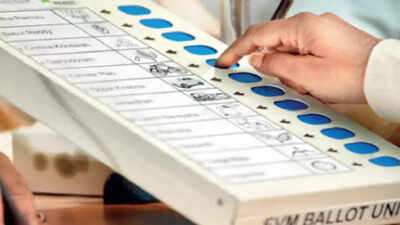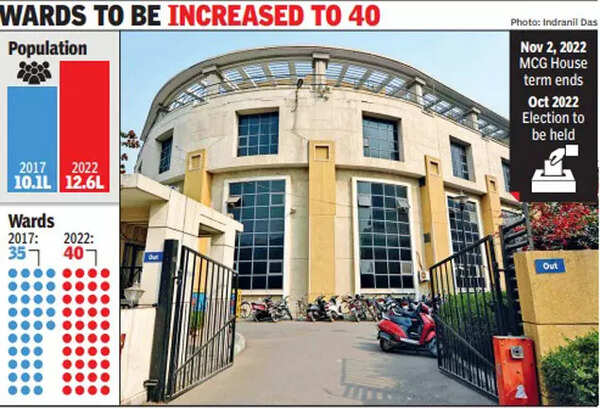- News
- City News
- gurgaon News
- Civic polls likely in October, Gurugram to vote for a mayor the first time
Civic polls likely in October, Gurugram to vote for a mayor the first time

Representative image
GURUGRAM: With the completion of the population survey, the delimitation of wards in the city will soon begin for the upcoming civic body polls that will see people voting to directly elect the mayor for the first time.

An ad-hoc committee for the delimitation is likely to complete the process by July 25, officials said. The MCG house term ends on November 2 and elections are likely to be held some time in October.
The number of wards will also be increased from 35 to 40 with the new population metrics — it has risen to 12.6 lakh from around 10.1 lakh in 2016. A total of 16 villages as well as some new sectors near the Dwarka Expressway and Golf Course Road (Extension) were added to the MCG limits in December 2020. Though an elected mayor will be more powerful, the MCG will continue to be headed by the commissioner.
Deputy commissioner Nishant Yadav told TOI, “The district administration will constitute an ad-hoc committee for working out the delimitation of wards. The population survey is already complete and the total population will be divided in 40 equal parts for the delimitation process, which is likely to be completed by July 25. After that, a notification will be issued (likely in September).”
The number of wards in any corporation is fixed by the state government on the basis of population. According to the Haryana Municipal Corporation Delimitation of Ward Rules, 1994, a corporation with a population between 9 lakh and 10 lakh has 32 wards, while it’s 35 wards for a population between 10 lakh and 12 lakh. Similarly, a corporation with a population between 12 lakh and 15 lakh has 40 wards and it’s 45 for a population exceeding 15 lakh. “Of these 40 wards, seven will be reserved for Scheduled Caste candidates and 14 for women, including three SC women. The reserved seats will be decided as per a draw of lots,” the DC said.
According to the 2011 Census, the city’s population was around 9 lakh, while the civic body’s survey billed it as 10.1 lakh. Due to this difference in the data, the delimitation of wards got stuck in 2016 and the civil body polls were deferred for nearly a year and half. Later, an ad-hoc committee confirmed that the population in the city was more than 10 lakh and the number of wards remained 35.
With the cabinet’s nod on direct mayoral poll, the state government aims at strengthening its hold over the local bodies. This time, the voters in Gurugram will not only cast their ballots for the ward councillor but also the mayor.
Sources in the corporation claimed that the directly elected mayor would wield more powers than before and greater influence in the jurisdiction under the civic body. The move would ensure that the mayor can function independently, without the pressure of councillors. This is because after the direct elections, the mayor will not be dependent on the support of councillors to remain in power.
The directly elected mayor will have the power to review the performance of civic body officials up to the level of executive engineers.

An ad-hoc committee for the delimitation is likely to complete the process by July 25, officials said. The MCG house term ends on November 2 and elections are likely to be held some time in October.
The number of wards will also be increased from 35 to 40 with the new population metrics — it has risen to 12.6 lakh from around 10.1 lakh in 2016. A total of 16 villages as well as some new sectors near the Dwarka Expressway and Golf Course Road (Extension) were added to the MCG limits in December 2020. Though an elected mayor will be more powerful, the MCG will continue to be headed by the commissioner.
Deputy commissioner Nishant Yadav told TOI, “The district administration will constitute an ad-hoc committee for working out the delimitation of wards. The population survey is already complete and the total population will be divided in 40 equal parts for the delimitation process, which is likely to be completed by July 25. After that, a notification will be issued (likely in September).”
The number of wards in any corporation is fixed by the state government on the basis of population. According to the Haryana Municipal Corporation Delimitation of Ward Rules, 1994, a corporation with a population between 9 lakh and 10 lakh has 32 wards, while it’s 35 wards for a population between 10 lakh and 12 lakh. Similarly, a corporation with a population between 12 lakh and 15 lakh has 40 wards and it’s 45 for a population exceeding 15 lakh. “Of these 40 wards, seven will be reserved for Scheduled Caste candidates and 14 for women, including three SC women. The reserved seats will be decided as per a draw of lots,” the DC said.
According to the 2011 Census, the city’s population was around 9 lakh, while the civic body’s survey billed it as 10.1 lakh. Due to this difference in the data, the delimitation of wards got stuck in 2016 and the civil body polls were deferred for nearly a year and half. Later, an ad-hoc committee confirmed that the population in the city was more than 10 lakh and the number of wards remained 35.
With the cabinet’s nod on direct mayoral poll, the state government aims at strengthening its hold over the local bodies. This time, the voters in Gurugram will not only cast their ballots for the ward councillor but also the mayor.
Sources in the corporation claimed that the directly elected mayor would wield more powers than before and greater influence in the jurisdiction under the civic body. The move would ensure that the mayor can function independently, without the pressure of councillors. This is because after the direct elections, the mayor will not be dependent on the support of councillors to remain in power.
The directly elected mayor will have the power to review the performance of civic body officials up to the level of executive engineers.
FOLLOW US ON SOCIAL MEDIA
FacebookTwitterInstagramKOO APPYOUTUBE
Start a Conversation
end of article










